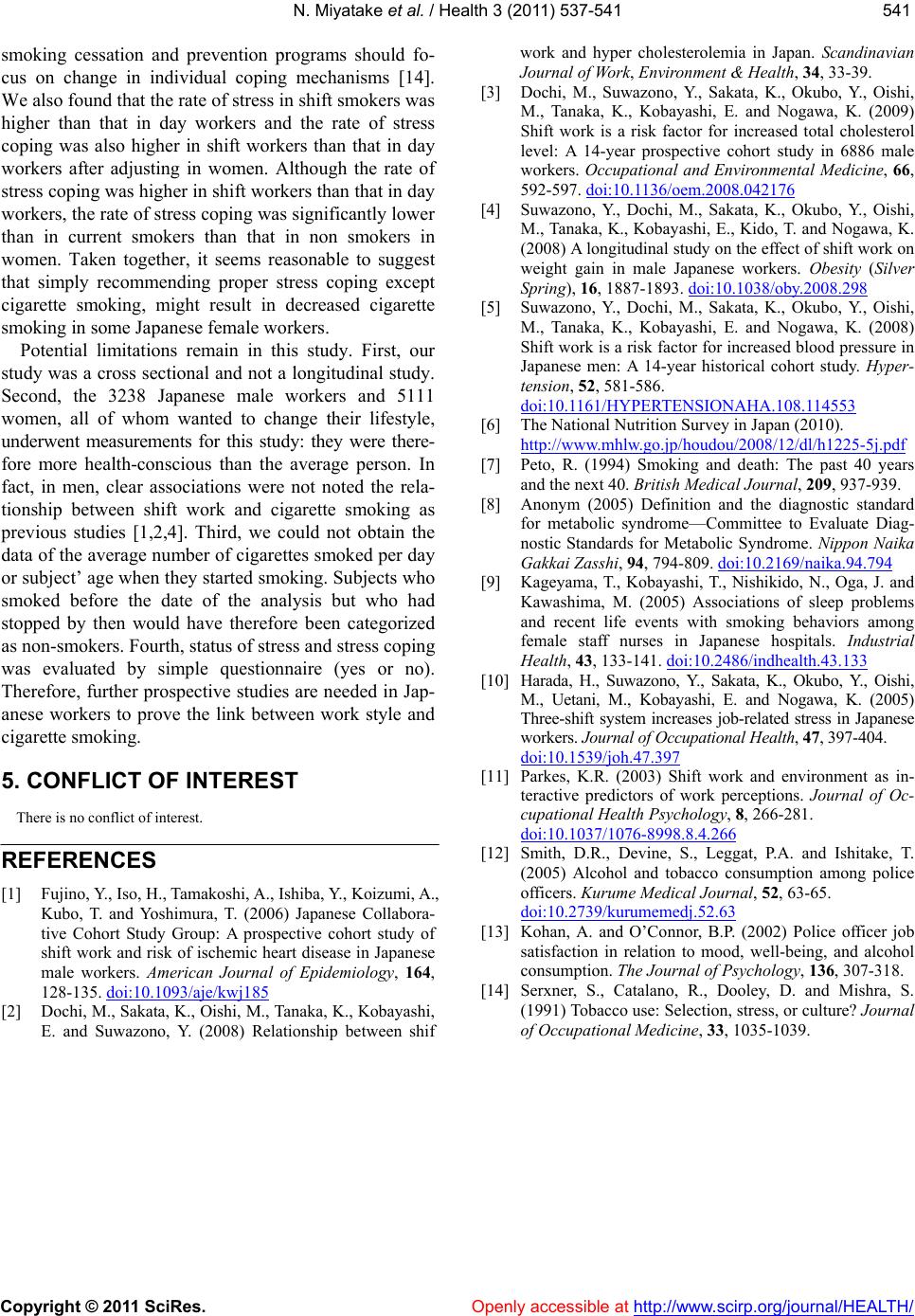
N. Miyatake et al. / Health 3 (2011) 537-541
Copyright © 2011 SciRes. Openly accessible at http://www.scirp.org/journal/HEALTH/
541541
smoking cessation and prevention programs should fo-
cus on change in individual coping mechanisms [14].
We also found that the rate of stress in shift smokers was
higher than that in day workers and the rate of stress
coping was also higher in shift workers than that in day
workers after adjusting in women. Although the rate of
stress coping was higher in shift workers than that in day
workers, the rate of stress coping was significantly lo wer
than in current smokers than that in non smokers in
women. Taken together, it seems reasonable to suggest
that simply recommending proper stress coping except
cigarette smoking, might result in decreased cigarette
smoking in some Japanese female workers.
Potential limitations remain in this study. First, our
study was a cross sectional and not a longitudinal study.
Second, the 3238 Japanese male workers and 5111
women, all of whom wanted to change their lifestyle,
underwent measurements for this study: they were there-
fore more health-conscious than the average person. In
fact, in men, clear associations were not noted the rela-
tionship between shift work and cigarette smoking as
previous studies [1,2,4]. Third, we could not obtain the
data of the average number of cigarettes smoked per day
or subject’ age when they started smoking. Subjects who
smoked before the date of the analysis but who had
stopped by then would have therefore been categorized
as non-smokers. Fourth, status of stress and stress coping
was evaluated by simple questionnaire (yes or no).
Therefore, further prospective studies are needed in Jap-
anese workers to prove the link between work style and
cigarette smoking.
5. CONFLICT OF INTEREST
There is no conflict of interest.
REFERENCES
[1] Fujino, Y., Iso, H., Tamakoshi, A., Ishiba, Y. , Koizumi, A .,
Kubo, T. and Yoshimura, T. (2006) Japanese Collabora-
tive Cohort Study Group: A prospective cohort study of
shift work and risk of ischemic heart disease in Japanese
male workers. American Journal of Epidemiology, 164,
128-135. doi:10.1093/aje/kwj185
[2] Dochi, M., Sakata, K., Oishi, M., Tanaka, K., Kobaya shi,
E. and Suwazono, Y. (2008) Relationship between shif
work and hyper cholesterolemia in Japan. Scandinavian
Journal of Work, Environment & Health, 34, 33-39.
[3] Dochi, M., Suwazono, Y., Sakata, K., Okubo, Y., Oishi,
M., Tanaka, K., Kobayashi, E. and Nogawa, K. (2009)
Shift work is a risk factor for increased total cholesterol
level: A 14-year prospective cohort study in 6886 male
workers. Occupational and Environmental Medicine, 66,
592-597. doi:10.1136/oem.2008.042176
[4] Suwazono, Y., Dochi, M., Sakata, K., Okubo, Y., Oishi,
M., Tanaka, K., Kobayashi, E., Kido, T. and Nogawa, K.
(2008) A longitudinal study on the effect of shift work on
weight gain in male Japanese workers. Obesity (Silver
Spring), 16, 1887-1893. doi:10.1038/oby.2008.298
[5] Suwazono, Y., Dochi, M., Sakata, K., Okubo, Y., Oishi,
M., Tanaka, K., Kobayashi, E. and Nogawa, K. (2008)
Shift work is a risk factor for increased blood pressure in
Japanese men: A 14-year historical cohort study. Hyper-
tension, 52, 581-586.
doi:10.1161/HYPERTENSIONAHA.108.114553
[6] The National Nutrition Survey in Japan (2010).
http://www.mhlw.go.jp/houdou/2008/12/dl/h1225-5j.pdf
[7] Peto, R. (1994) Smoking and death: The past 40 years
and the next 40. British Medical Journal, 209, 937-939.
[8] Anonym (2005) Definition and the diagnostic standard
for metabolic syndrome—Committee to Evaluate Diag-
nostic Standards for Metabolic Syndrome. Nippon Naika
Gakkai Zasshi, 94, 794-809. doi:10.2169/naika.94.794
[9] Kageyama, T., Kobayashi, T., Nishikido, N., Oga, J. and
Kawashima, M. (2005) Associations of sleep problems
and recent life events with smoking behaviors among
female staff nurses in Japanese hospitals. Industrial
Health, 43, 133-141. doi:10.2486/indhealth.43.133
[10] Harada, H., Suwazono, Y., Sakata, K., Okubo, Y., Oishi,
M., Uetani, M., Kobayashi, E. and Nogawa, K. (2005)
Three-shift system increases job-related stress in Japanese
workers. Journal of Occupational Health, 47, 397-404.
doi:10.1539/joh.47.397
[11] Parkes, K.R. (2003) Shift work and environment as in-
teractive predictors of work perceptions. Journal of Oc-
cupational Health Psychology, 8, 266-281.
doi:10.1037/1076-8998.8.4.266
[12] Smith, D.R., Devine, S., Leggat, P.A. and Ishitake, T.
(2005) Alcohol and tobacco consumption among police
officers. Kurume Medical Journal, 52, 63-65.
doi:10.2739/kurumemedj.52.63
[13] Kohan, A. and O’Connor, B.P. (2002) Police officer job
satisfaction in relation to mood, well-being, and alcohol
consumption. The Journal of Psychology, 136, 307-318.
[14] Serxner, S., Catalano, R., Dooley, D. and Mishra, S.
(1991) Tobacco use: Selection, stress, or culture? Journal
of Occupational Medicine, 33, 1035-1039.